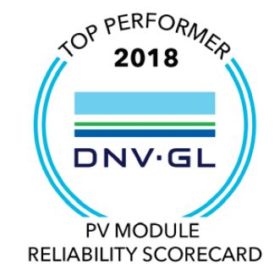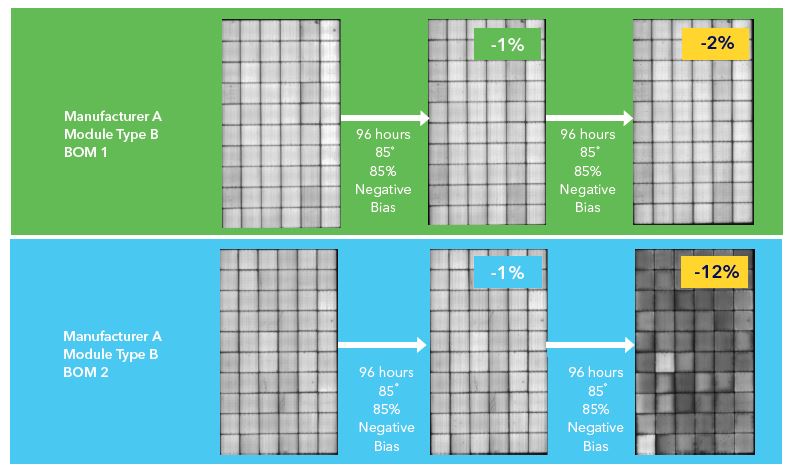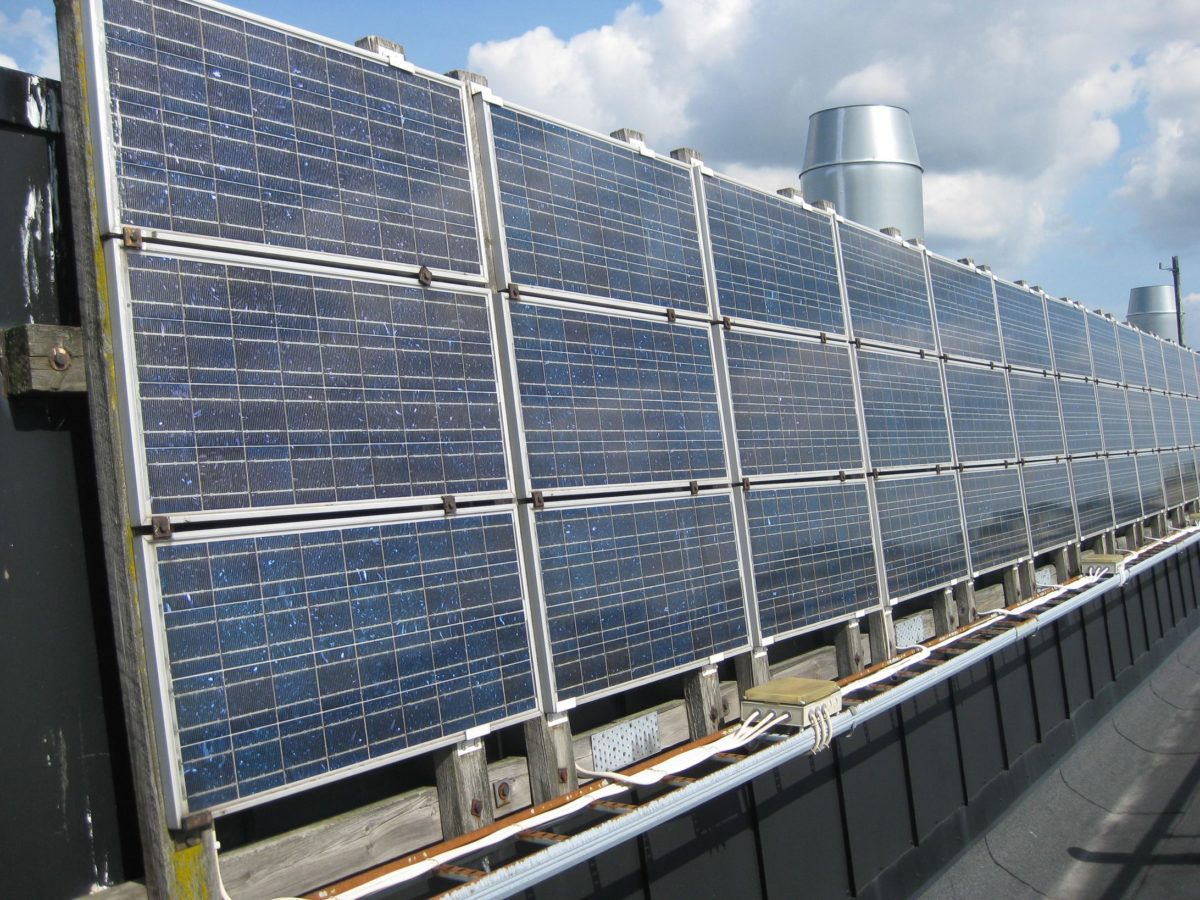Utility scale solar power purchase agreements have been increasing in length: 25 years and longer, with 25 year extension options. Utilities are obviously seeing value in decades of predictable electricity at a fixed price.
Kyocera, back in 2011, showed off a 1991 installation which it says ran with a “near-constant” efficiency level. The company has another solar power plant, recently verified, that’s been running since 1984 in Japan. SunPower’s modeling – backed by field research – suggests that 99% of their products have a 40 year useful life (meaning above 70% of original output). And SolarCity has suggested that standard solar modules from the big, cost focused players can run just fine for 35 years.
pv magazine sat down with Tara Doyle, head of business development at DNV GL, and Tristan Erion-Lorico, head of PV module business, at Intersolar North America to get their thoughts on the factors behind longevity – or lack thereof – in PV modules.
If you aspire to make great solar modules, DNV GL would suggest absolute quality control across the full bill of materials as their research shows that degradation decades out – or sometimes just months – is heavily dependent upon a discerning eye at the finest level. The company released these thoughts in their 2018 PV Module Reliability Scorecard (in browser viewer).
DNV GL – a global quality assurance and risk management company – puts solar module manufacturers through a broad suite of product examinations that takes many weeks, and demands up to 43 solar modules in the process. The company, whose origins stretch to 1864, generated $2.3 billion in revenue in 2017, from its 350 offices in 100 countries.

Erion-Lorico said of the up to 16 test procedure (above image),
What we really want to do is have results that repeat what happens in the field. If these modules were in the field they’d go through all of these pressures.
It’s no longer enough to test a “manufacturer” and assume consistency for all of their solar modules. As noted, solar module quality varies based upon the bill of materials, but there’s also variance based upon the factory where the modules are being assembled.
This is why DNV GL suggests that among the best practices for large developers to follow when choosing solar modules, is to follow solar module model choice with a review of the bill of material components, then to pick the subcomponents you want included, and lastly to send a spot checker to the factory making your modules specifically.
 Part of being a 2018 Top Performer means that DNV GL will actually be that employee on site of manufacturing, spot checking the materials going into their tests. And as part of DNV GL’s services provided, these documents, with these specific bill of materials components and their testing results, will be provided – free of charge – to module buyers so they can continue their investment research.
Part of being a 2018 Top Performer means that DNV GL will actually be that employee on site of manufacturing, spot checking the materials going into their tests. And as part of DNV GL’s services provided, these documents, with these specific bill of materials components and their testing results, will be provided – free of charge – to module buyers so they can continue their investment research.
DNV GL likens their process to a “living program”. Tests change a bit every year. Driven mostly by buyers, but also by manufacturers. For instance, in recent times module manufacturers have been able to nearly eliminate cell mismatch. Erion-Lorico suggested its an “almost solved problem”. In 2017 two tests were refined – Normal Operating Cell Temperature (NOCT) and hot spot testing.
When DNV GL participated in the pv magazine Quality Roundtable at Intersolar Europe 2018, and they and other noted they’re looking closely at underperforming backsheets. At the roundtable, TÜV Rheinland’s Jorg Althaus presented an analysis, Latest amendment of IEC 61730 and its impact on backsheet quality assurance (PDF). The leading slide suggested that:
Cost saving strategies of the last 6 years lead to material thickness minimization and introduction of backsheets designed to meet minimum requirements, rather than being made to last.
Makes you wonder what kind of special sauce Kyocera brewed back in the early 1980s.
There is of course a balance that DNV GL considers. There is the cost and the time it takes to test. In the aggressively evolving solar module world, the timing of testing is of the utmost importance. The longest test – the climate chamber – spends 80 days increasing and decreasing temperatures, from -40°C to 85°C. In 2016-2017, this cycling occurred 600 times. In 2018 and 2019, it will increase to 800 times.

The above image comes from a case study in the scorecard on page 22. It focuses on Potential Induced Degradation (PID). At a high level, PID results from ions escaping the solar module through various components – glass, mounting, frame, etc. The end result is that the solar modules deliver fewer of those sweet, sweet kWhs.
The two modules above are from the same manufacturer, and are the same module model number. Their difference lay only in the bill of materials – specifically, per DNV GL, the difference between the two is the encapsulation sealing the solar cells and circuits from the environment. One badly performing sub-component of a solar module, which itself is a subcomponent an of entire solar project, is enough to drag down everyone’s performance mere months into a life.
Of additional significance is how DNV GL’s assessment process itself had to evolve in order to recognize these defects. Note that after the first round of testing, 96 hours, the two modules have an equal output degradation value of -1%. The full difference wasn’t delivered until a second 96-hour test finished, when the two products’ performance separated immensely.
DNV GL determined that while 96 hours wasn’t enough, 600 hours of testing – which had been considered – was too much. And in making this call, DNV GL took the time to “test the test”.

The evolution of testing, as noted being mostly driven by downstream buyers, is heavily aimed toward decreasing the financial risk of projects from the perspective of bankers. As a result, information on specific solar modules – as in the 2018 Scorecard – has been formatted to more easily deliver key data to non-technical personnel. This meant moving information from data tables into graphical presentation and smartly shaped imagery.
DNV GL feels their product lowers risk because the tests don’t take for granted a global brand name, or even a high-quality model within that brand name. The test lowers risk because it takes into account the ever-evolving solar module manufacturing landscape. DNV GL stands closely by the developers as they’re putting billions of dollars into the dirt, and then pushes the manufacturers by quantifying the challenges that arise after leaving the manufacturing lines. These quantifications are then communicated to all in a way that allows a 25-year spreadsheet to translate it into sound judgement calls on multi-decade investments.
One could argue the company sells peace of mind. Quite fitting when we see that their initials – DNV – are short for Det Norske Veritas, or in English, “The Norwegian Truth.”
This content is protected by copyright and may not be reused. If you want to cooperate with us and would like to reuse some of our content, please contact: editors@pv-magazine.com.








This is quite an interesting article.
This type of work being done by DNV GL can also be useful to regular consumers. I will surely be following these test results and the efficacy of the testing in general.
Test away.